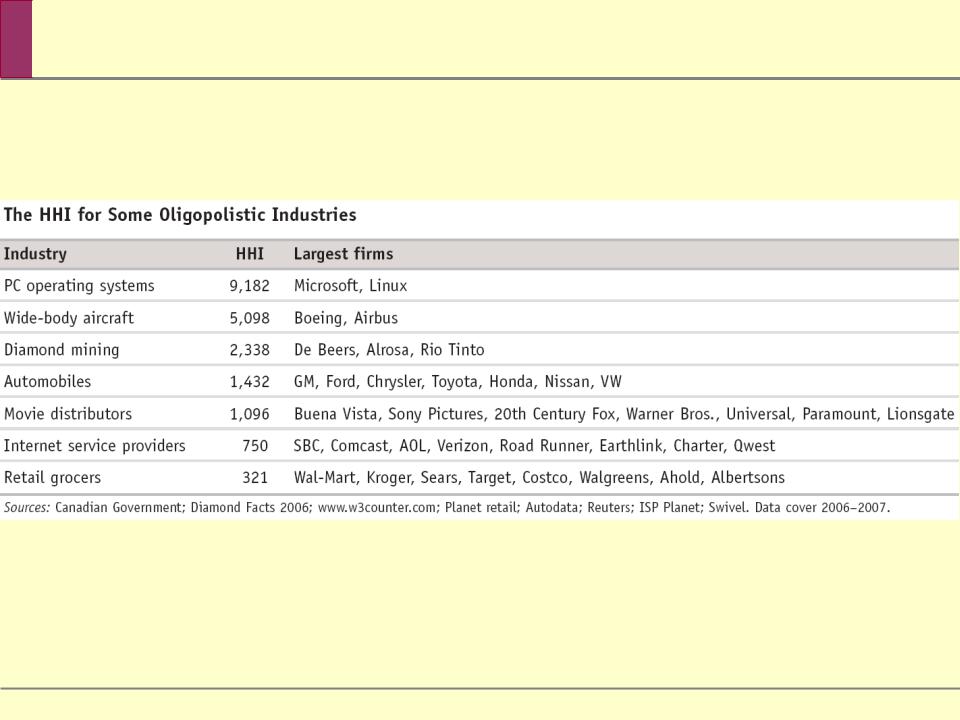
Lectures_micro / Microeconomics_presentation_Chapter_15
.pdf
chapter:
15
>> Oligopoly
Krugman/Wells
Economics
©2009 Worth Publishers

WHAT YOU WILL LEARN IN THIS CHAPTER
The meaning of oligopoly, and why it occurs
Why oligopolists have an incentive to act in ways that reduce their combined profit, and why they can benefit from collusion
How our understanding of oligopoly can be enhanced by using game theory, especially the concept of the prisoners’ dilemma
How repeated interactions among oligopolists can help them achieve tacit collusion
How oligopoly works in practice, under the legal constraints of antitrust policy


 The Prevalence of Oligopoly
The Prevalence of Oligopoly
In addition to perfect competition and monopoly, oligopoly and monopolistic competition are also important types of market structure. They are forms of imperfect competition.


 The Prevalence of Oligopoly
The Prevalence of Oligopoly
Oligopoly is a common market structure.
It arises from the same forces that lead to monopoly, except in weaker form.
It is an industry with only a small number of producers.
A producer in such an industry is known as an oligopolist.


 The Prevalence of Oligopoly
The Prevalence of Oligopoly
When no one firm has a monopoly, but producers nonetheless realize that they can affect market prices, an industry is characterized by imperfect competition.


 Some Oligopolistic Industries
Some Oligopolistic Industries


 Understanding Oligopoly
Understanding Oligopoly
Some of the key issues in oligopoly can be understood by looking at the simplest case, a
duopoly.
An oligopoly consisting of only two firms is a duopoly. Each firm is a duopolist.
With only two firms in the industry, each would realize that by producing more, it would drive down the market price. So each firm would, like a monopolist, realize that profits would be higher if it limited its production.


 Understanding Oligopoly
Understanding Oligopoly
One possibility is that the two companies will engage in collusion. Sellers engage in collusion when they cooperate to raise each others’ profits.
The strongest form of collusion is a cartel, an agreement by several producers to obey output restrictions in order to increase their joint profits.
They may also engage in non-cooperative behavior, ignoring the effects of their actions on each others’ profits.


 Understanding Oligopoly
Understanding Oligopoly
By acting as if they were a single monopolist, oligopolists can maximize their combined profits. So there is an incentive to form a cartel.
However, each firm has an incentive to cheat—to produce more than it is supposed to under the cartel agreement. So there are two principal outcomes: successful collusion or behaving non-cooperatively by cheating.
When firms ignore the effects of their actions on each others’ profits, they engage in non-cooperative behavior. It is likely to be easier to achieve informal collusion when firms in an industry face capacity constraints.


 Competing in Prices vs. Competing in Quantities
Competing in Prices vs. Competing in Quantities
Firms may decide to engage in quantity or price competition.
The basic insight of the quantity competition (or the Cournot model) is that when firms are
restricted in how much they can produce, it is easier for them to avoid excessive competition and to “divvy up” the market, thereby pricing above marginal cost and earning profits.
It is easier for them to achieve an outcome that looks like collusion without a formal agreement.
